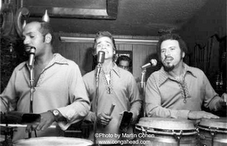.JPG)
At the La Conga nightclub in 1945, Graciela Perez broke the restraints of propriety and virtuousness the night she sang “Sí Sí No No.” The band fell silent, the waiters froze, the dancing stopped, and the bartender turned to witness her daring performance.
Beginning off to the side, she slowly edged center-stage under brighter lighting. She personified womankind facing an eternal seductive, copulative proposition. Her agile voice nursed a suspenseful scenario that gradually submitted to normal desire. Within this framework, Graciela reached a melodic dénouement, an artful pseudo-orgasmic celebration ending in an ecstatic climactic scream. This was music to the ears of every male present.
Her startling melodramatics had no encore. Here was a breakthrough similar to Sally Rand’s very daring fan dance, Josephine Baker’s nudity, and Miguelito Valdez’s “Babalu” number at the uptight, Anglo-centric Waldorf Astoria. She hit us the way Valentino’s tango did, then Isadora Duncan and Madonna, but without their universal celebrity. We had been presented with a revolutionary event, like a morality play vocalized. It was one that lyrically mimicked a Shakespearean dueling scene between rival moral principles. Her act liberated a stale, sexually correct post–WWII America at a time when Club El Morocco denied entry to women wearing sunglasses. Graciela taunted a tight-laced society wherein any indelicate intimacy was taboo, except in crass vaudevillian skits on red-light Forty-Second Street.
The patrons at La Conga’s rumba matinees were dancers and their “pupils,” garment-center “cloak-and-suiters” with their models, and gigolettes. The dance floor was a smoldering tinderbox of erotic performances, with groins riveted to groins. This was reminiscent of the old Park Plaza where, during slow, grinding selections such as “El Negro Simón,” the lyrics described a girl becoming arrebata, or sexually uncontrollable. With Yoruba language working, i.e., arrullendole caguá, lusty interpretations were left to the inflamed imaginations of the dancers. These odd, throaty sounds seemed to imply foreplay. Since the messages in these unintelligible lyrics were decoded by each dancer according to his or her level of arousal, there was sufficient amplitude for each individual to respond physically, blaming the Afro music for their suggestive behavior on the floor. The musicians, as well as the outnumbered Latino dance couples, encouraged the Anglos to interpolate the feral sensuality surrounding them, while clownish antics of frustrated beginners were perceived with good humor by everyone.
When a Latino danced with an Anglo girl, she would perform with exaggerated responses in dances that glorified femininity and the macho man. The result was a greater abandonment with newfound freedom of movement. The male Anglo, his heretofore secure role threatened, eschewed the Afro-Cuban dance world, whereas his partner now saw it as part of her overall liberation—and would again during the 1970s, when disco dancing meant less male control. The Stonewall historical event is a good example of a revolution beginning on the dance floor.
Graciela’s substantial voice that night in 1944 ignited an overheated environment. Unless you had witnessed her, you would not have realized what it all meant. Her coquettish, beguiling, pantomime with needless lyrics nevertheless left us with a climactic, playful portrayal of a female’s victory over a manipulated male, despite their mutually responsive libidos. She gracefully and cleverly flaunted her newly liberalized instinct, using “Si Si No No” as a musical vehicle for freedom of greater expression without vulgarity.
Graciela came from a background where a 1930s rumba, “El Plato Roto,” spoke of a broken hymen. It was one of many risqué numbers that, like spice, were welcome ingredients in Cuba’s everyday life and torrid musical climate. It recalls a more restrained, delightful combination of feminine musical beauty, the eleven-piece Retunda All-Girl Orchestra, whose redolence infused Havana in the forties, as did that of Orquesta Anacaona, which of course featured Graciela.
In an alley behind one Havana nightclub, El Pasaje, a well-worn upright piano was stored during the day, available to anyone who might wish to play it. It was known by everyone and was often found encircled by Habaneros, like fraternity boys singing their alma mater. At night it was rolled out on wheels to the narrow sidewalk in front of the brightly lit club. Passersby clustered there, enjoying free concerts under the open sky. That piano seemed to belong to everyone, like the remarkable music that one heard throughout the city. The people of Havana, like those in Washington Heights, fell asleep with late-night radios playing sexy love songs.
Everyone owned Graciela in their hearts, especially in Havana. Alongside Anacaona in popularity was a second all-girl orchestra. At times, both bands played the number-one hit in unison. This all took place opposite El Capitolio, and was a nightly happy spectacle symbolizing and celebrating a country where rumba was Cuba and Cuba was rumba. Music was like a second government.
But it was Graciela who helped make us, here in the States, a bit more liberal.




